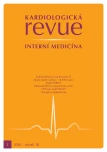Cardiac cachexia
Authors:
M. Valentová 1; E. Goncalvesová 2
Authors‘ workplace:
Oddelenie kardiológie a pneumológie, Univerzitná klinika Göttingen, Nemecko
1; Oddelenie zlyhávania a transplantácie srdca, Národný ústav srdcových a cievnych chorôb, Bratislava, Slovensko
2
Published in:
Kardiol Rev Int Med 2016, 18(1): 28-30
Category:
Cardiology Review
Overview
Cardiac cachexia is a common manifestation of advanced to terminal phases of heart failure syndrome of any origin. Cachexia presents as a decrease of muscle, fat and bone tissue, and is associated with a significant decrease in exercise capacity. The pathogenesis of this condition consists of anabolic-catabolic imbalance in association with anorexia and malabsorption. The molecular basis of these processes is the subject of intensive research, intended particularly to detect targets for a potential pharmacological intervention and reversion of this adverse metabolic condition. Physical training is currently the most effective method of prevention and treatment of cardiac cachexia accepted in clinical practice. Nutritional strategies have a supportive effect. Specific pharmacological treatment is not yet available.
Keywords:
cardiac cachexia – definition – prognosis – physical training
Sources
1. Anker SD, Ponikowski P, Varney S et al. Wasting as independent risk factor for mortality in chronic heart failure. Lancet 1997; 349 : 1050 – 1053.
2. Oreopoulos A, Padwal R, Kalantar-Zadeh K et al.Body mass index and mortality in heart failure: a meta-analysis. Am Heart J 2008; 156 : 13 – 22. doi: 10.1016/ j.ahj.2008.02.014.
3. Evans WJ, Morley JE, Argilés J et al. Cachexia: a new definition. Clin Nutr 2008; 27 : 793 – 799. doi: 10.1016/ j.clnu.2008.06.013.
4. Anker SD, Negassa A, Coats AJ et al. Prognostic importance of weight loss in chronic heart failure and the effect of treatment with angiotensin-converting-enzyme inhibitors: an observational study. Lancet 2003; 361 : 1077 – 1083.
5. Anker SD, Ponikowski PP, Clark AL et al. Cytokines and neurohormones relating to body composition alterations in the wasting syndrome of chronic heart failure. Eur Heart J 1999; 20 : 683 – 693.
6. Sandek A, Bauditz J, Swidsinski A et al. Altered intestinal function in patients with chronic heart failure. J Am Coll Cardiol 2007; 50 : 1561 – 1569.
7. Arutyunov GP, Kostyukevich OI, Serov RA et al. Collagen accumulation and dysfunctional mucosal barrier of the small intestine in patients with chronic heart failure. Int J Cardiol 2008; 125 : 240 – 245. doi: 10.1016/ j.ijcard.2007.11.103.
8. Valentova M, von Haehling S, Krause C et al. Cardiac cachexia is associated with right ventricular failure and liver dysfunction. Int J Cardiol 2013; 169 : 219 – 224. doi: 10.1016/ j.ijcard.2013.08.134.
9. Melenovsky V, Kotrc M, Borlaug BA et al. Relationships between right ventricular function, body composition, and prognosis in advanced heart failure. J Am Coll Cardiol 2013; 62 : 1660 – 1670. doi: 10.1016/ j.jacc.2013.06.046.
10. Polak J, Kotrc M, Wedellova Z et al. Lipolytic effects of b-type natriuretic peptide1 – 32 in adipose tissue of heart failure patients compared with healthy controls. J Am Coll Cardiol 2011; 58 : 1119 – 1125. doi: 10.1016/ j.jacc.2011.05.042.
11. McMurray JJ, Adamopoulos S, Anker SD et al. ESC Guidelines for the diagnosis and treatment of acute and chronic heart failure 2012. The Task Force for the Diagnosis and Treatment of Acute and Chronic Heart Failure 2012 of the European Society of Cardiology. Developed in collaboration with the Heart Failure Association (HFA) of the ESC. Eur J Heart Fail 2012; 14 : 803 – 869. doi: 10.1093/ eurjhf/ hfs105.
12. Martins T, Vitorino R, Moreira-Gonçalves D et al. Recent insights on the molecular mechanisms and therapeutic approaches for cardiac cachexia. Clin Biochem 2014; 47 : 8 – 15. doi: 10.1016/ j.clinbiochem.2013.10.025.
13. Bowen TS, Schuler G, Adams V. Skeletal muscle wasting in cachexia and sarcopenia: molecular pathophysiology and impact of exercise training: J Cachexia Sarcopenia Muscle 2015; 6 : 197 – 207. doi: 10.1002/ jcsm.12043.
14. Rozentryt P, von Haehling S, Lainscak M et al. The effects of a high-caloric protein-rich oral nutritional supplement in patients with chronic heart failure and cachexia on quality of life, body composition, and inflammation markers: a randomized, double-blind pilot study. J Cachexia Sarcopenia Muscle 2010; 1 : 35 – 42.
15. Aquilani R, Opasich C, Gualco A et al. Adequate energy-protein intake is not enough to improve nutritional and metabolic status in muscle-depleted patients with chronic heart failure. Eur J Heart Fail 2008; 10 : 1127 – 1135. doi: 10.1016/ j.ejheart.2008.09.002.
16. Mehra MR, Lavie CJ, Ventura HO et al. Fish oils produce anti-inflammatory effects and improve body weight in severe heart failure. J Heart Lung Transplant 2006; 25 : 834 – 838.
Labels
Paediatric cardiology Internal medicine Cardiac surgery CardiologyArticle was published in
Cardiology Review

2016 Issue 1
Most read in this issue
- Proton pump inhibitors – new molecules, new knowledge
- What to use in patients with ischaemic heart disease and atrial fibrillation – anticoagulation, antiaggregation or both?
- Cardiac cachexia
- Hyperuricaemia, cardiovascular diseases and heart failure
